Sequence architecture of a Jurassic ramp succession from Gebel Maghara (North Sinai, Egypt): Implications for eustasy
Ahmed Awad Adelhady *, Franz Theodor Fürsich
a Geology Department, Faculty of Science, Minia University, 61519 Minia, Egypt
b FG Pal?oumwelt, Geozentrum Nordbayern der Universit?t Erlangen, Loewenichstrasse 28,D-91054 Erlangen, Germany
KEYWORDS facies;sequence stratigraphy;ramp;extensional basin;Jurassic;Gebel Maghara;Egypt
Abstract The Jurassic succession at Gebel Maghara, North Sinai, Egypt, represents a mixed carbonate-siliciclastic sequence. Combining information from both fossils and rocks allowed a plausible reconstruction of the depositional environments and of the basin evolution. The Jurassic succession of Gebel Maghara was deposited on a ramp, and the architecture of the ramp facies was strongly controlled not only by sea-level changes but also by extensional tectonics in connection with rifting of the Tethys, North Gondwana. Seven tectonically modified thirdorder sequences (DS 1-DS 7) have been recognized. The first three sequences (DS 1-DS 3),ranging from the Toarcian to the Bajocian, record sea invasion (intertidal to shallow subtidal conditions) across an intracratonic area as a result of eustatic sea-level changes during a quiescent rift stage. The remaining sequences (DS 4-DS 7) reflect open marine mid to outer ramp settings. Non-marine conditions around the Bajocian-Bathonian boundary, documented by caliche, represent the maximum regression of the sea. During an active extensional stage,horsts, which formerly acted as barriers separating the Maghara sub-basin from the main ocean, subsided. Subsequent rejuvenation and reactivation of faults shifted the homoclinal physiography of the ramp to a distally steepened ramp during the early Bathonian, creating a 200-m-thick deltaic wedge. Similar processes during the early Kimmeridgian created a calcirudite-calcarenite succession of slope origin. The diversity and the epifaunal/infaunal percentage of the macrofauna display a cyclic pattern which coincides more or less with the sequence stratigraphic architecture.
1 Introduction
Gebel Maghara is a dome-like structure covering an area of approximately 400 km2, and situated in northern Sinai, 50 km south of the Mediterranean coast (Fig. 1). It comprises the thickest and the most complete Jurassic outcrop in northern Sinai (1800 m; Fig. 2; Al Far, 1966;Keeley, 1994), and provides an excellent testing ground for assessing the interplay of eustacy and tectonics in ramp depositional environments. The Jurassic succession at Gebel Maghara represents a sequential development of continental and marine sediments, starting in the Early Jurassic (Toarcian) and lasting until the Late Jurassic (Kimmeridgian; Al Far, 1966). In the large anticlinal structure, the large-scale sedimentary architecture of the strata is superbly exposed, making the recognition of facies associations possible even from a satellite image. These excellent exposures are ideal for stratigraphic investigations.
The sedimentological and stratigraphical frameworks have been previously discussed (e.g., Abdelhady and Fürsich, 2015a; Al Far, 1966; Douvillé, 1916; Hirsch, 1980; Issawi et al., 1999; Keeley et al., 1990; Picard and Hirsch,1987; Said and Barakat, 1958). However, great uncertainties still exist, especially with respect to the depositional environments.
The Jurassic strata of Egypt exhibit strong eustatic and tectonic influences (Keeley and Wallis, 1991). During the Late Triassic and the Early Jurassic, northern Sinai was located on an extensional rift margin, and in such settings,facies and sequence architecture are highly influenced by tectonics (e.g., Herkat and Guiraud, 2006; Jackson et al.,2005; Khalil and McClay, 2008; Winn et al., 2001; Young et al., 2000). Ruffell (1998) demonstrated that tectonically enhanced sequence boundaries may be discerned from those of eustatic origin.
The facies of the Jurassic succession at Gebel Maghara exhibit a broad range and rapid lateral and vertical changes, partly caused by synsedimentary tectonics. Consequently, new interpretations of the facies architecture and provenance are urgently needed for constructing a sound depositional model. The purpose of this paper is to reconstruct the depositional environments of the area to illustrate the control of both eustacy and tectonics on facies patterns by investigating the geometry, lateral continuity,and stacking pattern of facies.
2 Geologic and tectonic setting
The Triassic Tethys rifting in North Gondwana, accompanied by thermal subsidence of the lithosphere, led to the formation of small intracratonic subbasins (horst-graben systems) with differential subsidence in northern Egypt(Ayyad et al., 1998; Garfunkel, 1998, 2004; Keeley, 1994;Moustafa et al., 1998). Gebel Maghara is one of these subbasins, consisting of an extensional half-graben-like structure. These rift basins were filled with both continental siliciclastic and marine carbonate sediments. The opening of the basin started in the Late Triassic-Early Jurassic (Biju-Duval et al., 1979; Garfunkel and Derin, 1984; Mart, 1987).
On a regional scale, the Maghara Basin is part of an ENEWSW oriented Jurassic basin in the North Sinai-Levant area, called the Maghara-Halal Basin (Picard and Hirsch,1987). However, changes in thickness of the Jurassic rocks between Gebel Maghara and the Halal-1 Well indicate the existence of separate sub-basins in northern Sinai (Gebel Maghara, Halal, and Yelleg). The same tectonic setting has been reported from the northern Western Desert of Egypt (e.g., Abd El-Aziz et al., 1998; Moustafa et al., 1998;Wescott et al., 2011).
The opening of the Neotethys resulted in the development of E-W to ENE-orientated faults (Hirsch, 1984). These faults dip northward in the Eastern Desert, producing a regional northerly sloping platform (Bein and Gvirtzman,1977; Garfunkel and Derin, 1984). The resulting facies were thick marine carbonates and shales in the north and shallow marine, thin siliciclastics to the south (Yousef et al., 2010).
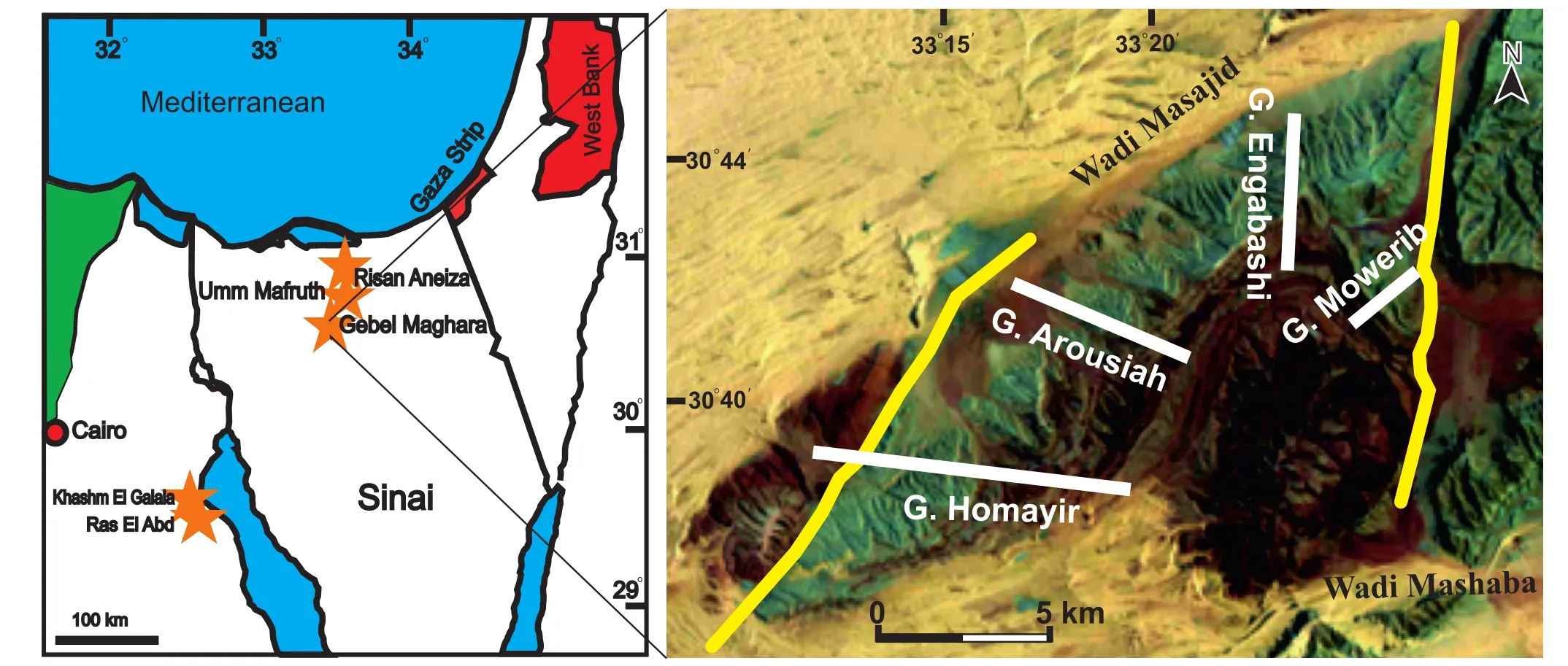
Figure 1 Jurassic outcrops in Egypt and landsat image of the Gebel Maghara area showing positions of the four sections. G. = Gebel.
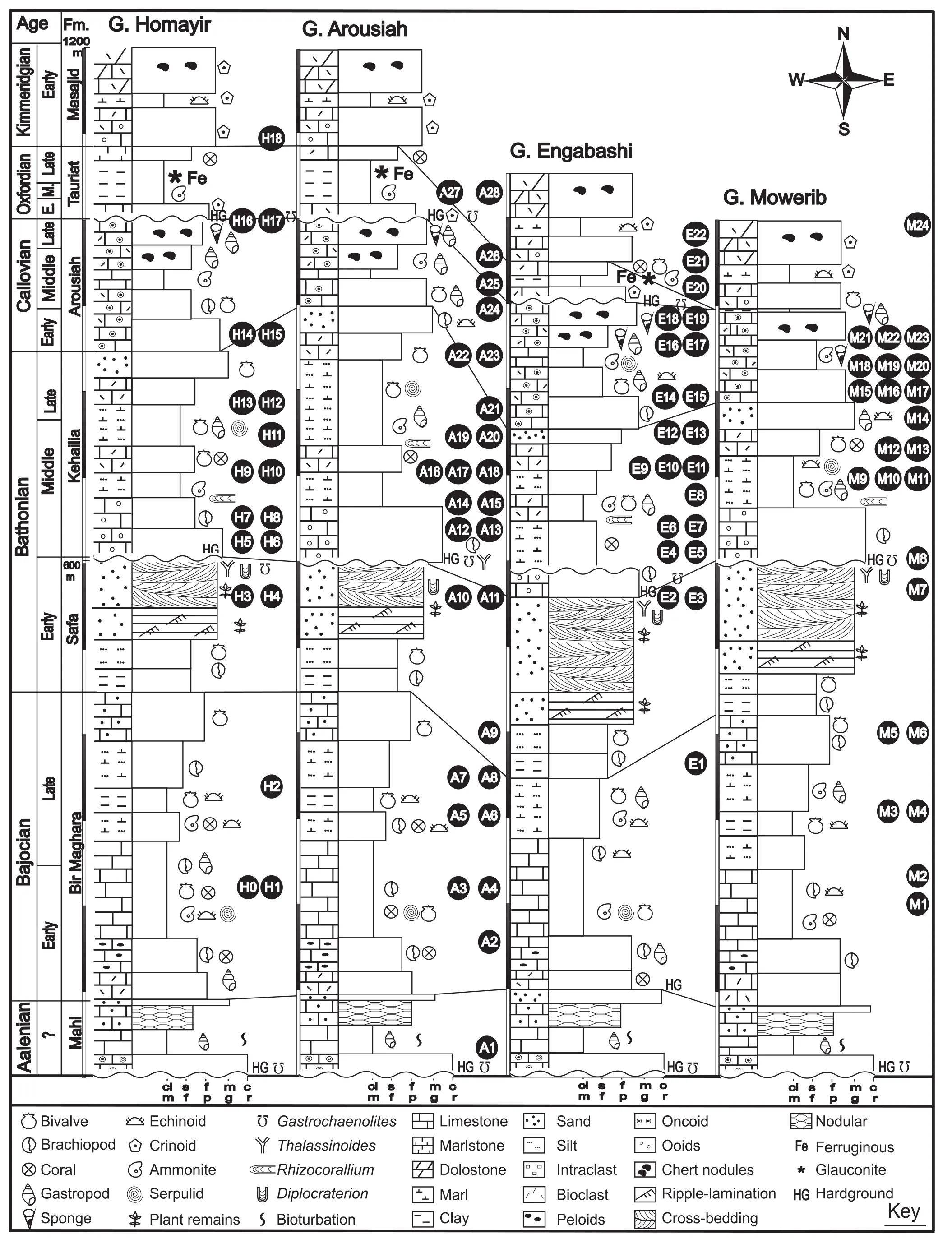
Figure 2 Stratigraphic columns of the measured sections with positions of macrofossil samples (from Abdelhady and Fürsich, 2014; op.cit. Figure 2). Formation boundaries after Abdelhady and Fürsich (2015a).
The northern Galala fault separates two facies, a peritidal facies in the north (mainly fine siliciclastics) and a fluvial one in the south (mainly coarse siliciclastic). The Great Bitter Lake Fault separates the southern peritidal facies and the thick shallow marine facies in the north, thus indicating that the northern Galala Fault and the Great Bitter Lake Fault formed during the Early Jurassic (see also Sestini, 1984).
The Jurassic rocks at Gebel Maghara are composed of mixed carbonate-siliciclastics of deltaic to shallow-marine origin. The Middle to Upper Jurassic succession varies in thickness from 1100 m (Al Far, 1966) to 1400 m (Picard and Hirsch, 1987) and 850 m (Mazhar et al., 1993). We have measured four sections (1190 m, 1177 m, 1025 m, and 995 m thick, respectively) from west to south. These differences in thickness probably are related to tectonics and lateral facies changes, but to some extent may also be caused by repetition due to a large landslide that is locally present in the Bajocian Bir Maghara Formation (Kuss, 1990). All these factors may influence the observed thicknesses.
Al Far (1966) divided the Maghara succession into marine and continental strata. The marine strata are represented by the Rajabiah, Bir Maghara, and Masajid formations,whereas the continental strata include the Mashabba, Shusha, and Safa formations. A meandering river system existing in the south apparently deposited its sediments into the Maghara Subbasin. These rivers deposited parts of their sediments inland forming a thin fluvial sequence to the south, which may have been flooded briefly during peak transgression (Al Far, 1966).
Picard and Hirsch (1987) modified Al Far′s classification and compared the succession at Gebel Maghara with that of the adjacent Negev Desert. Keeley and Wallis (1991) provided a stratigraphic scheme for the Jurassic sediment of the western Desert, which can be more or less correlated to the rock succession at Gebel Maghara (Fig. 3). The present paper concentrates on the Middle-Upper Jurassic rocks,which yield a rich fauna. Recently, Abdelhady and Fürsich(2015a) subdivided the Middle-Upper Jurassic succession of Gebel Maghara based on a quantitative biostratigraphic tool into seven formations (Fig. 3).
3 Material and methods
Fieldwork was carried out for several weeks during March to May, 2012. It involved a survey of the complete area and the selection of four sections in a 20-km-long W-E transect for detailed study. Three sections (Gebel Homayir,Gebel Arousiah, and Gebel Engabashi) belong to the western flank of the anticline with a dip of the strata varying from 15° to 30°, while the Gebel Mowerib section is exposed on the eastern flank, dipping at an angle exceeding 60° in some parts (Fig. 1).
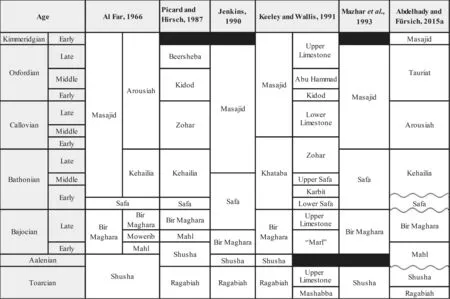
Figure 3 Chronostratigraphic correlation chart for the Jurassic formations of Gebel Maghara (black blocks indicate gaps; wavy line indicates unconformity). The left columns refer to formations, the right columns to members.
In order to resolve the facies arrangement of the single cycles and overall sequence architecture, the four sections were measured in detail (e.g., type of lithology, colour,grain size, sedimentary structures, bioturbation, macrofossils, ichnotaxa, and taphonomic features of biogenic hardparts; Fig. 2) using a modified Jacob Staff, hand lens, and 10% HCL. Samples were taken during logging when thought appropriate, and where significant facies and lithological changes were observed. Information on body and trace fossils were taken in the field and quantitative samples were collected. Analysis of carbonate rocks using the hand lens in the field were combined with detailed microfacies studies. Thirty-five thin-sections were used to investigate the compositional variation of both limestone and sandstone beds in all sections. Each sample was viewed under a Carl Zeiss optical microscope connected to a digital camera“Cyber-shot”. The images obtained were transmitted to a personal computer and were analyzed by Axion Vision v4.8 software. The macrofauna was prepared in the laboratory and identified down to the species level wherever possible.
The classification used to characterize the microfacies follows Dunham (1962). Standard microfacies type (SMT)classification schemes of Flügel (2004) and Wilson (1975),and ramp microfacies types (RMT) of Flügel (2004) were applied. Sedimentary structures, colour, trace fossils, and grain size were the main criteria for siliciclastic facies interpretation. Depositional settings and palaeoenvironmental reconstructions of carbonates were interpreted based on compositional, textural, and fabric data and by comparison with modern environments (Tucker and Wright,1990). Microfacies were reported along a ramp profile distinguishing three main facies belts: outer, mid, and inner ramp (Burchette and Wright, 1992; Read, 1985). Delta type and delta facies were interpreted according to Renaud and Kuenzer (2012) and Wright (1985).
4 Facies associations
The distribution pattern of the microfacies in Gebel Maghara reflects transgression from tidal environments of the inner ramp at the base to relatively deep-water environments of the outer ramp at the top of the succession (Table 1). Thirty-five different facies types have been recognized and grouped into eight depositional environments ranging from deltaic, tidal, restricted lagoon, open lagoon, and shoal, to middle ramp, slope, and outer ramp. Vertical and lateral facies architecture indicates that sedimentation took place on a carbonate ramp which physiographically varied from homoclinal to distally steepened (see below).
4.1 Inner ramp
The homoclinal ramp model (Burchette and Wright,1992) distinguishes between inner, middle, and outer ramp.Inner ramp sediments are deposited in an agitated environment above the fair-weather wave-base (FWWB). It ranges from the shallow subtidal to the intertidal zone. Lagoonal settings sheltered by barriers may develop (Tucker, 1985).In mixed siliciclastic-carbonate rocks of the inner ramp,sandy allochemic limestones (composed of ooids, bioclasts,and lithoclasts) are the most common rock types. Small patch reefs may also occur.
The inner ramp facies in Gebel Maghara are widespread in both the Mahl and Bir Maghara formations. They include tidal deposits of fine-grained sandy mudstones and dolomitized algal wackestones with an admixture of quartz grains. Phosphatic ooidal grainstones, sandstones, and bioclastic-ooidal packstones probably correspond to sandy shoals and banks of the inner ramp. Protected lagoonal settings of the inner ramp are characterized by peloidal packstones. Sediments formed in open-marine settings of the inner ramp are bioclastic packstones (Table 1).
4.2 Middle ramp
Middle ramp deposits consist mainly of packstones or grainstones deposited above the storm wave-base (SWB).Sedimentation is therefore highly influenced by variable storm intensity (Burchette and Wright, 1992; Flügel, 2004).Autochthonous and allochthonous shells occur. In Gebel Maghara the sediments of the mid-ramp are represented by bioturbated, glauconitic foraminifera-ostracod oncoidal wackestones to packstones and were recorded from the Kehailia, Arousiah and Tauriat formations (Table 1).
4.3 Outer ramp
The outer ramp is dominated by thin, laminated beds of terrigenous mud, with parautochthonous and autochthonous shells. Skeletal wackestones dominate, some lime mud forming in situ (Tucker, 1985). The presence of ammonites and belemnites indicates a comparatively distal environment. The absence of primary sedimentary structures produced by currents or waves suggests a low-energy environment probably located below the storm wave-base(SWB) (Table 1). The outer ramp deposits of Gebel Maghara are represented by spiculitic wackestones and bioclastic mudstones to wackestones in addition to ammonite-bearing marl and glauconitic shales. Mid-outer ramp sediments are typical of the Kehailia and Arousiah formations (Table 1).
4.4 Slope
The distally steepened ramp of Gebel Maghara tectonically developed from a previous homoclinal ramp. Echinoderm grainstones represent the slope facies and constitute the Masajid Formation. The sediments of the slope are largely autochthonous to par-autochthonous. Slumping and breccia deposits are of minor importance. Bioclastic ooidal grainstones and rudstones characterize the slope. It resembles the ramp model proposed for the Upper Triassic shelf and platform margins in the northern Calcareous Alps by Stanton and Flügel (1995).
4.5 Delta
The early Bathonian Safa Formation represents an upward-coarsening siliciclastic succession typical of a deltaic setting. It comprises prodelta (shale, silt, and clay),delta front (rippled sandstone), and distributary channel(low-angle trough cross-bedded sandstone) subenvironments. The total thickness of these deltaic sediments is 200 m. The occurrence of elongated tidal bars and periodic abandonment surfaces in addition to numerous channels indicate the tide-dominated delta type (the action of
tidal currents significantly overprints that of channel flow;see Renaud and Kuenzer, 2012). Tide-dominated deltas are directly connected to the sea via a series of distributary channels that are typically flanked by low-lying vegetated flood plains and swamp areas (the source of coal deposits at Gebel Maghara; Table 1). For detailed facies descriptions see Abdelhady (2014).
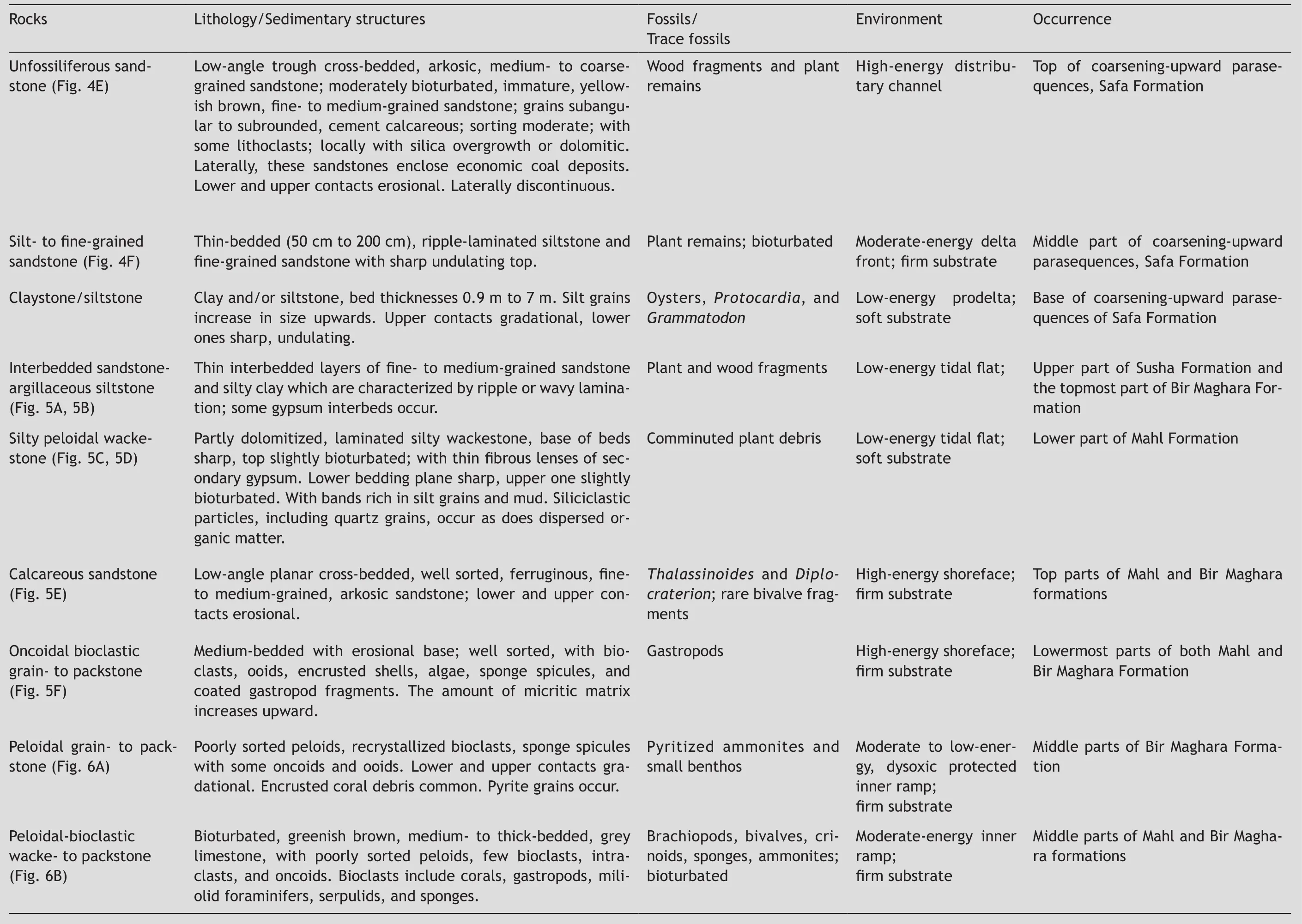
Table 1 Description and interpretation of the mainfacies associations
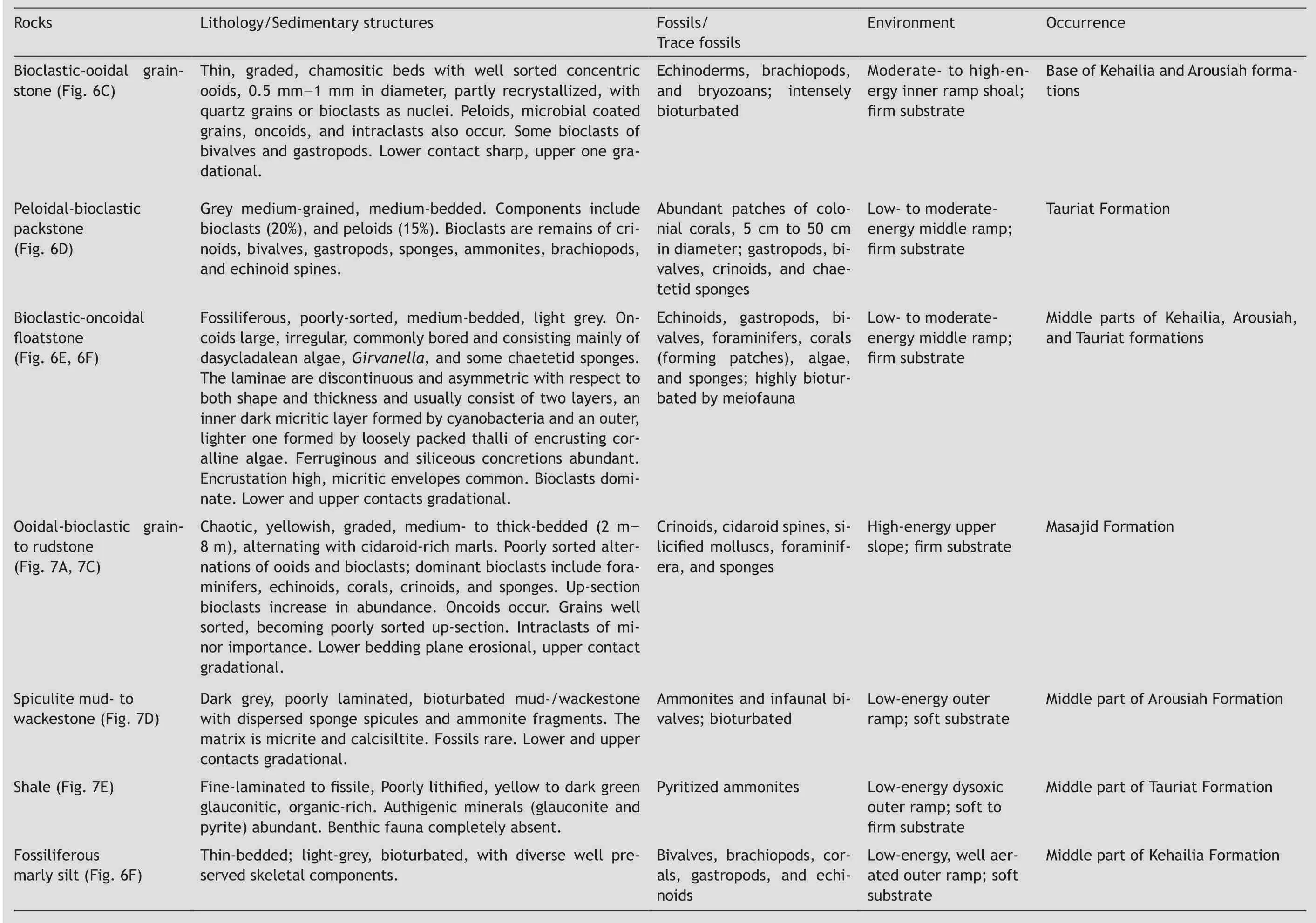
Table 1, continued
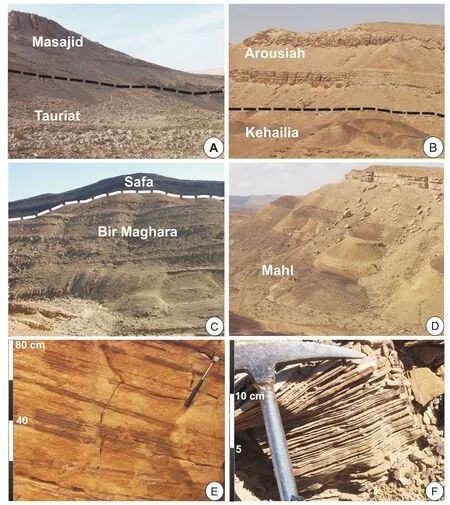
Figure 4 Outcrop photographs of the Middle and Upper Jurassic formations exposed in the area of Gebel Maghara. A-Tauriat/Masajid contact at Gebel Engabashi; B-Kehailia/Arousiah contact at Gebel Arousiah; C-Bir Maghara/Safa contact, east of Bir Maghara, at Gebel Engabashi; D-Mahl Formation exposed at Wadi El-Mahl; E-Low-angle trough cross-bedded ferruginous sandstone, Safa Formation; FRipple-laminated sandstone, Safa Formation.
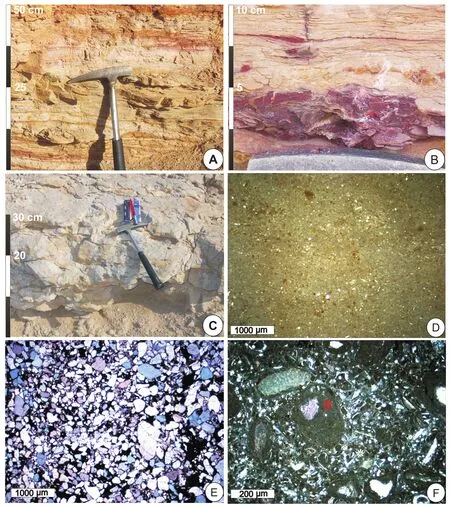
Figure 5 Outcrop photographs and photomicrographs (taken under plane polarized light except where stated otherwise) of the proximal inner ramp facies; A-Wavy interbedded siliciclastics of tidal origin, top of Shusha Formation; B-Flaser bedded sandstone, the sand lenses are ferruginous and bounded by laminations of silt and clay, top of the Bir Maghara Formation; C-Partially dolomitic wackestone, the dark dolomitic patches vary from few millimeters up to 25 cm, Mahl Formation; D-Algal wackestone, Mahl Formation; E-Poorly sorted arkosic sandstone, photographed under crossed nicols, of shoreface origin, Bir Maghara Formation; F-Poorly washed oncoidal-bioclastic grainstone to packstone (S: Chaetetid sponge) from the lower part of the Mahl Formation (detailed description of the facies/microfacies is given in Abdelhady, 2014).
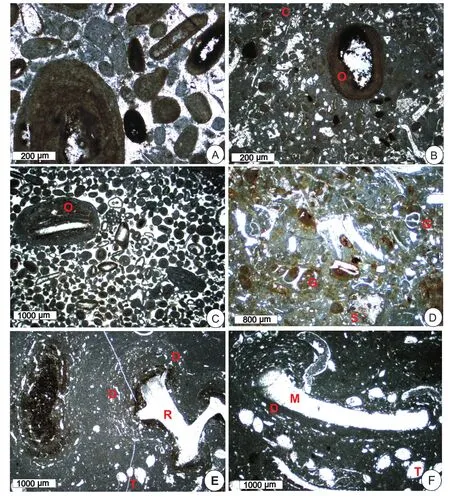
Figure 6 Photomicrographs (taken under plane polarized light) of the inner and middle ramp facies. A-Peloidal grainstone, Bajocian Bir Maghara Formation; B-Peloidal-bioclastic wackestone to packstone. (C: Cidaroid spine; O: Oncoid), Bajocian Bir Maghara Formation; CPeloidal-ooidal grainstone, upper part of Kehailia Formation; D-Peloidal-bioclastic packstone (G: Gastropod; S: Chaetetid sponge), lower part of the Oxfordian Tauriat Formation; E-F-Bioclastic-oncoidal floatstone, middle part of the Callovian Arousiah Formation; E-Algaloncoidal floatstone; oncoid crust composed of discontinuous dark ferruginous and light laminae (D: Microbial crust; T: Trocholina; R: Red algae); F-Trocholina-oncoidal floatstone (M: Mollusc; T: Trocholina; D: Microbial crust). Note the thick microbial crust around the shell fragment.
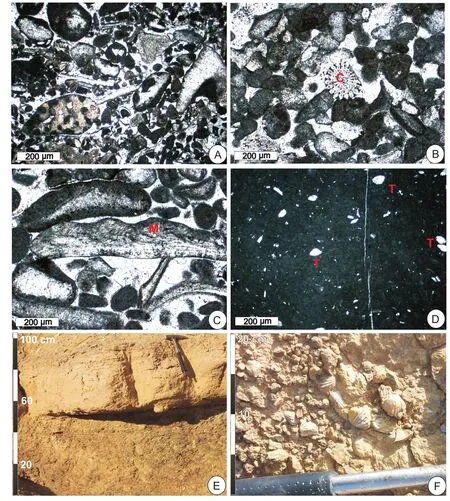
Figure 7 Outcrop photographs and photomicrographs (all in plane polarized light) of the slope and outer ramp facies. A-C-Chaotically arranged crinoidal bioclastic grainstone to rudstone in sparry calcite cement, lower part of the Kimmeridgian Masajid Formation. Most bioclasts are heavily bored by microborers (C: Cidaroid spine; M: Mollusc fragment); D-Trocholina (T) mudstone to wackestone, middle part of Arousiah Formation; E-Glauconitic shale, middle part of the Oxfordian, Tauriat Formation; F-Marl with the rhynchonellid brachiopod Daghanirhynchia angulocostata (Cooper, 1989), Bathonian Kehailia Formation.
5 Sequence stratigraphy
5.1 General issues
Third-order sequences were dated based on quantitative biostratigraphic analysis of the collective macrofauna (Abdelhady and Fürsich, 2015a), while the duration of fourth-order sequences was estimated by dividing the duration of the third-order cycle by the number of the fourthorder ones. The same procedure was carried out for the parasequences. Of course, unconformable surfaces and sedimentation breaks have to be taken into consideration,but in our opinion, each sequence includes new deposits,reworked deposits, and sedimentary gaps. The combination of these three components of a sequence makes it unique and provides a simple picture of the palaeoenvironment.Although the thickness and duration of the sequences vary from one environment to another, they are still within a specific range at least for the Jurassic succession of Gebel Maghara.
The smallest cycles are meter-scale marl-limestone successions, interpreted as parasequences (Van Wagoner et al., 1988). Larger depositional sequences are decameterscale (5 m to 15 m thick). They record a few hundred thousand years, comparable to fourth-order cycles of Vail et al.(1991). Larger-scale sequences have thicknesses of several tens of meters and inferred durations of about 1-3 million years (third-order sequences; Vail et al., 1991). Boundaries of large sequences are marked in most cases by an erosional surface, while those of smaller ones are marked by sharp contacts. The nature of the different parasequences as fourth-order cycles is summarized in Figures 8-9.
A significant criterion of lowstand systems tract (LST)sediments is the basinward shift of facies belts resulting from a relative sea-level fall and an abrupt upward transition to a significantly more proximal facies (Fig. 8). In shallower areas sub-aerial erosion may develop. Lowstand deposits are generally lacking in Gebel Maghara except in the Safa Formation (early Bathonian). Continental sedimentation of the Safa Formation took place under semihumid to humid, tropical conditions, with a steady supply of run-off material (Ghandour et al., 2003). Peat formed in hinterland swamps and lakes and was deposited in marginal marine areas, developing into paralic coal. The shoreline was tide-dominated as is indicated by the features mentioned above.
Transgressive systems tracts (TST) of shallow water areas show invasion of marine waters (Fig. 8D) and are marked by ooidal to bioclastic packstone/grainstones. The carbonate nature of the TST reflects reduction of siliciclastic input during sea-level rise. Some TST sediments show mineralized hardgrounds and an increasing content of reworked nodules, and of phosphatic, glauconitic or chamositic grains,indicating sediment starvation. In distal parts, the TST consists of bioclastic skeletal packstone to floatstone with an erosional base as in the case of the Arousiah Formation.
Maximum flooding zones (MFZ) are marked by finergrained deeper water sediments and occasionally hardground surfaces. Sediment starvation may have resulted from deepening and resulting lack of siliciclastic input.The MFZ consequently commonly represents comparatively condensed horizons (Fig. 7E). In addition, deposits containing chemically and mechanically resistant particles such as pyrite or glauconite are common (Baird and Brett, 1986,1991). The corrosion surface on top of limestones represents a considerable amount of time with non-sedimentation.
Highstand sediments in proximal areas are characterized by thin, wavy bedded packstone to grainstones or calcareous sandstone. In distal parts they consist of wackestones and marls, or dark, organic-rich clay or shales. Highstand systems tracts (HST) show coarsening-upward trends in most cases (Fig. 9B). An increase in coarser siliciclastic material in addition to the erosional contact associated with a rapid drop in sea level indicates a falling stage systems tract (FSST; Plint and Nummedal, 2000). It is not that easy to distinguish between the FSST and the LST, but according to Plint and Nummedal (2000), the FSST represents a sea-level fall whereas the LST represents a sea-level rise.The deltaic succession of the early Bathonian Safa Formation is a typical lowstand systems tract, which represents a successive and gradational sea level rise. In contrast, we have a sandstone body (which indicates a higher frequency sea-level fall) capping a carbonate sequence, in which the highstand systems tract is represented by packstones/grainstones.
Based on fossil content, thin-sections, bed-by-bed investigation of outcrops, and correlation of significant surfaces,the Middle-Upper Jurassic of Gebel Maghara is subdivided into seven distinct, correlative sequences (DS 1 to DS 7;Fig. 10). The following is a descriptive summary of these sequences.
5.2 Depositional sequences
DS 1 (Early Jurassic)
The Shusha Formation is part of an Early Jurassic cycle,which lies beyond the scope of the present study.
DS 2 (Aalenian)
The Shusha-Mahl contact is marked by an irregular corrosion surface. This unconformity represents the lower sequence boundary (SB) of DS 2. The absence of age-diagnostic fossils in the sediments above and below the unconformity makes an age determination very difficult, but Ash (1972) assigned an Early Jurassic age to the Shusha Formation based on the fossil plant Piazopteris branneri,collected from the Ain Sukhana section, 150 km south of Gebel Maghara. This sequence is comparable to the second Jurassic cycle of the Levant Margin (Perelis-Grossowicz et al., 2000), the lower part of the J30 of Haq and Al-Qahtani(2005), and the lower part of the Aalenian-lower Bajocian cycle of Gardosh et al. (2008). The sediments are generally very shallow, inner-shelf carbonates (intertidal to shore-face).
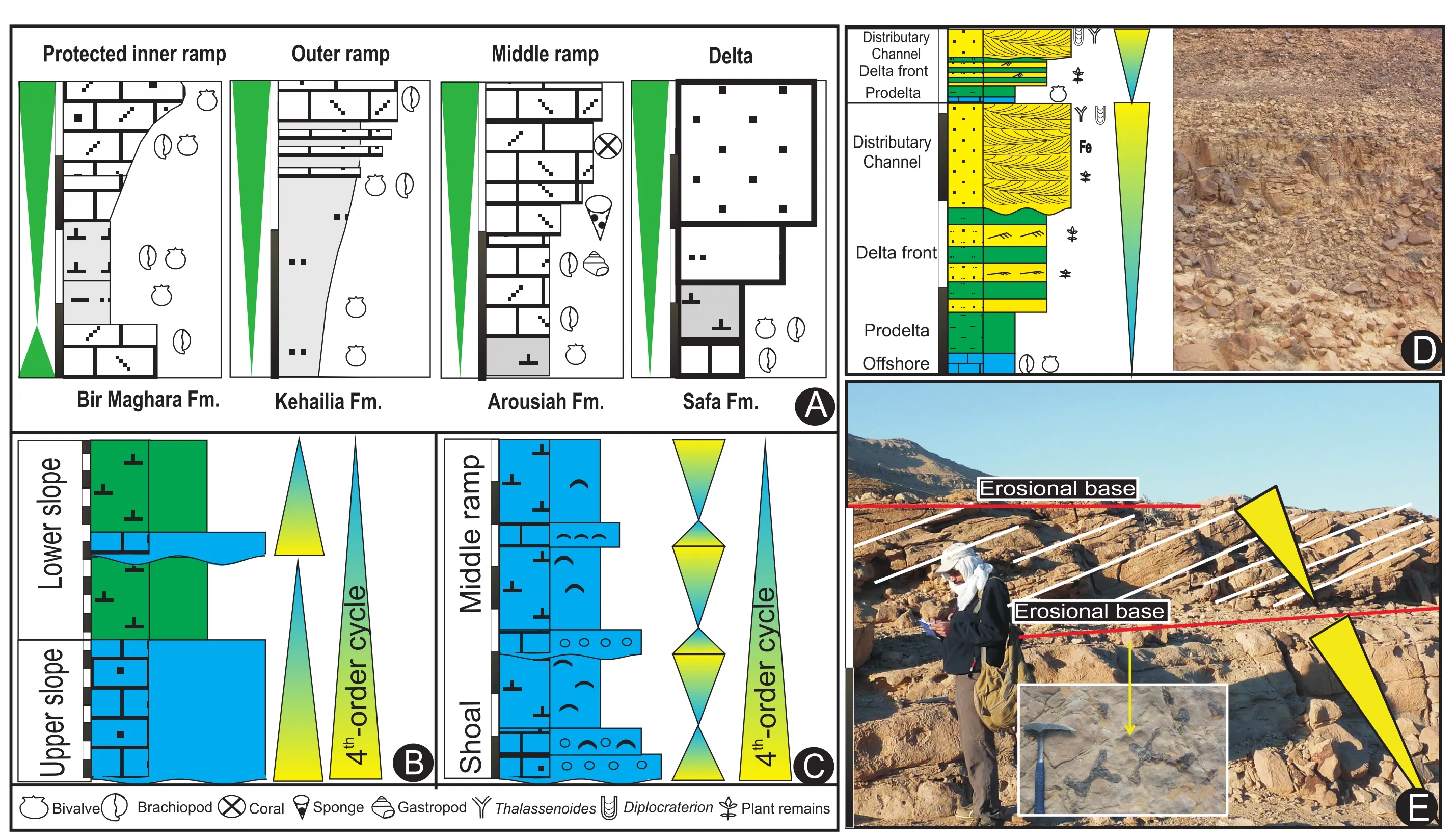
Figure8 A-Different diagrammatic types of shallowing-upwardparasequences. Fm. =Formation; B-Fourth-order cycleof theMasajid Formation, Gebel Engabashi section; C-Fourth-order cycle of theKehailiaFormation, Gebel Arousiah section; D-Coarsening-upwardparasequences in thelowstandsystems tract of theSafaFormation, Gebel Arousiah section; E-Planar crossbeddedsandbar at thetop of theSafaFormation, Gebel Arousiah section. Inset: Thetrace fossil Thalassinoides, preservedinsilica. Scale= 1m.
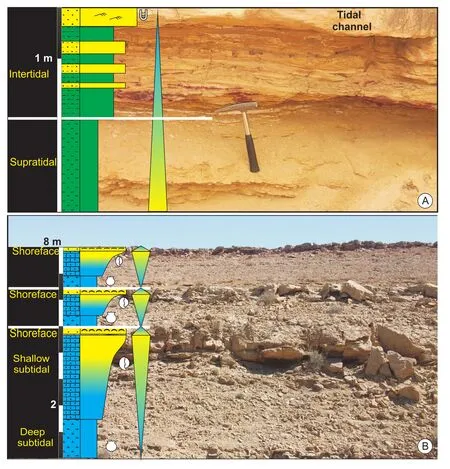
Figure 9 A-Deepening-upward parasequence from the base of the lowstand systems tract of Depositional Sequence 4, Safa Formation,Gebel Arousiah section. The supratidal “caliche” is followed by intertidal wavy fine-laminated intercalations of sand and clay; B-Highly asymmetric transgressive-regressive parasequences from the highstand systems tract of the Bir Maghara Formation, Gebel Engabashi section. Legend is the same as in Figure 2.
The transgressive sediments above the sequence boundary are oncoid grainstones with a sharp erosional base and a gradational, bioturbated top followed by marl. The TST sediments continue with sparitic rudstones. Only one fossil collection consisting of oysters, gastropods, and corals could be obtained from this interval, in which a high diversity (Shannon index = 1.59) suspension-feeding epifauna dominated. Diagnostic criteria of TST are graded, coarsegrained sediments with sharp bases. The thickness of TST varies among the sections studied. The MFZ is marked by fine-grained marl with a 2-m-thick bedded dolomitic wackestone intercalation with few small gastropods (mainly algae-grazing gastropods). The HST is characterized by algal wackestone beds; the clay and silt content becomes abundant up-section, and finally the Mahl Formation ends with a ferruginous sandy packstone, the top SB coinciding with the Mahl-Bir Maghara contact. The thickest HST deposits were recorded towards the East, in the Mowerib section. This cycle was deposited mainly in very shallow tidal environments. The Aalenian-lower Bajocian sequence was deposited during an active extensional rifting phase in an intracratonic setting. The cycle is 150 m thick and its duration was approximately 3 m.y.
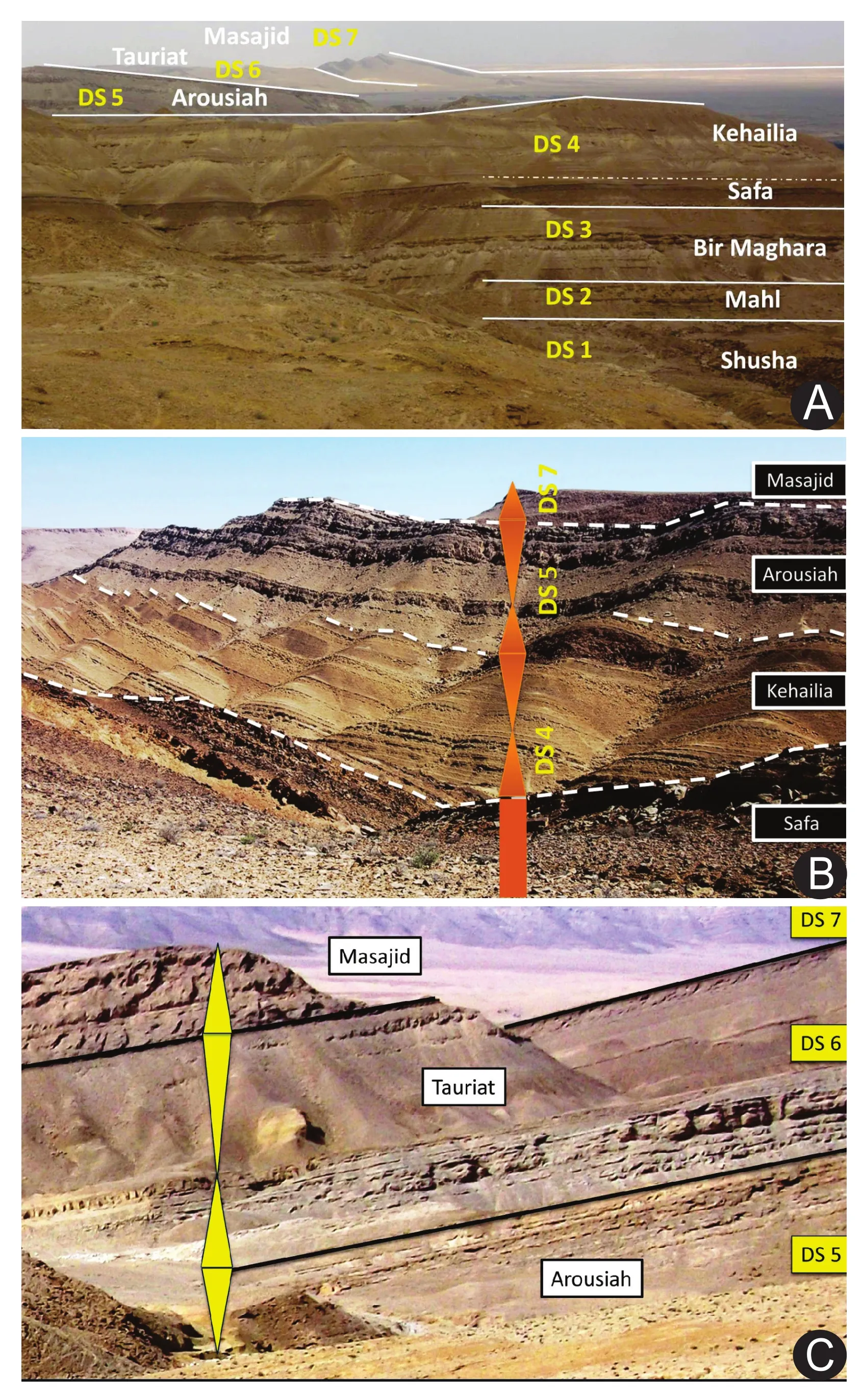
Figure 10 A-Architecture of the depositional sequences at Gebel Arousiah, western saddle of the anticline of Gebel Maghara; B-The depositional sequences of Gebel Mowerib, eastern saddle. Note the absence of the Tauriat Formation (DS 6); C-The upper three depositional sequences, exposed at Gebel Engabashi.
DS 3 (Bajocian)
The Bir Maghara Formation is characterized by a high siliciclastic content. The limestones vary from wackestones to grainstones. Algae and peloids are the dominant grains.The fossil content is high but patchy and of limited lateral continuity. DS 3 is equivalent to the third Jurassic cycle of Gardosh et al. (2008) and to the upper part of the J30 of Haq and Al-Qahtani (2005). The TST begins with transgressive oncoidal packstones to grainstones of the shoreface. In the macrofauna epibenthic suspension-feeders dominate.Species richness varies between 2 and 18. The maximum flooding deposits comprise peloidal-bioclastic wackestones with brachiopods and sponges. These wackestones are followed by marly silt rich in tiny pyritized ammonites. The macrofauna from this horizon is dominated either by diverse infaunal-deposit-feeders or less diverse, epifaunal suspension-feeders. A 5-m-thick shale bed rich in Bositra occurs twice and is interpreted to represent oxygen-poor,restricted inner ramp conditions, as these shales are fissile,with no sign of bioturbation and contain neither benthic nor nectonic fossils except the epifaunal bivalve Bositra(Abdelhady and Fürsich, 2014, 2015b). HST deposits form coarsening-upward cycles that start with marl and/or wackestone followed by packstone, whereby the concentration of sand grains increases up-section. The diversity and percentage of infaunal deposit-feeders decrease upward. The sequence is capped by ferruginous, well sorted,calcareous sandstone. This cycle was deposited mainly in an inner ramp setting varying from open to restricted under a continuous supply of terrigenous sediments. The late Bajocian cycle is 150 m to 250 m thick. The duration of the cycle is about 1 m.y.
DS 4 (Bathonian)
The contact between the Bir Maghara and the Safa Formation represents the sequence boundary. The deltaic deposits of the Lower Bathonian Safa Formation, composed of sandstones with intercalated siltstones and limestones,are interpreted to represent the LST of DS 4. The low diversity macrofauna is dominated by epifaunal suspensionfeeders. The transgressive sediments start with thin beds of chamositic ooidal grainstone and/or ooidal-bioclastic packstone. The diversity of the benthic associations, dominated by epifaunal suspension-feeders, is high and the diversity and proportion of infaunal deposit-feeders increases upward (Abdelhady and Fürsich, 2014; Table 2). A dark glauconitic mudstone bed with abundant individuals of the deep-burrowing bivalve Pholadomya represents the MFZ at Gebel Arousiah. In other sections, the MFZ is represented by very fossiliferous marly siltstone with occasional infauna. Ammonites have also been collected from this horizon. The HST consists mainly of marl which contains a low diversity fauna of epibenthic suspension-feeders. A 6-m-thick sandstone bed with intercalated bio-packstone and oncoidal-ooidal grainstone marks the top of the Bathonian sequence (FSST). This cycle was deposited in middle and outer ramp environments, except for the early TST and FSST, which were deposited in a shoal setting. The thickness of the Bathonian cycle is ~400 m. The duration of the cycle is ~2 m.y.
DS 5 (Callovian)
The Callovian sequence consists of a thinly bedded carbonate unit. Marls are of minor importance. Flint layers and nodules are common. Siliciclastic components are nearly absent. The sequence represents offshore environments of the lower middle to outer ramp. The TST sediments are generally obscured by debris; probably they are fine-grained bioclastic shales or marl. The first measured beds are coral-bearing floatstones. Debris of corals, stromatoporoids, and red algal fragments dominate. The most common fossils are nerineid gastropods. The macrobenthos is rich in epifaunal suspension-feeders. The MFZ is marked by a spiculitic mudstone with a diverse fauna dominated by endobenthic deposit-feeders. The MFZ does not correspond to a single bed and the boundaries between the systems tracts are not easy to define. The MFS (mfs; Maximum flooding surface) was placed at the base of a bed exhibiting condensation features (i.e., authigenic minerals, corrosion, intense encrustation, and skeletal concentrations).The HST part consists of thick-bedded bioclastic-oncoidal packstones. The lower part of the HST contains a high diversity fauna dominated by epifaunal suspension-feeders such as oysters, gastropods, regular echinoids, and sponges(for details see also Abdelhady and Fürsich, 2014, 2015b).This cycle was deposited mainly in an outer ramp setting.The thickness of the Callovian cycle is ~200 m, its duration was 2 m.y.
DS 6 (Oxfordian)
The Tauriat Formation represents the whole Oxfordian.Although the time interval represented by the Oxfordian sequence is the longest among all determined sequences(the duration of the cycle is ~7 m.y.) it is only 70 m thick,resulting from a certain degree of condensation. Early and Middle Oxfordian ammonites occur in the same lithological unit. A low rate of net sedimentation is also indicated by abundant authigenic minerals within this sequence. The TST is represented by bioclastic-oncoidal floatstone to rudstones characterised by very diverse epifaunal suspensionfeeders. The MFZ is a glauconitic fissile shale with a low diversity fauna of pyritized ammonites. Shales turn much darker and ammonites disappear up-section. In contrast,the HST deposits are lighter in colour and contain a few epifaunal bivalves and colonial corals. The Oxfordian sequence ends with a peloidal packstone bed.
Derin (1974) related the absence of the Kidod Shale(equivalent to the Tauriat Shale) in some areas of Israel to interfingering with carbonates. Gardosh et al. (2008)attributed the absence of the Kidod Formation to submarine erosion or non-deposition along an upper slope setting. In Gebel Maghara, the Tauriat Shale is absent only in the Mowerib section (Fig. 10B), where the Kimmeridgian Masajid Formation rests directly on the Callovian Arousiah Formation without any sign of erosion. The latter does not
support the interpretation of Gardosh et al. (2008). Open marine conditions are supported by the rich ammonite fauna and the glauconitic nature of the sediments. Open marine conditions of Oxfordian shales in the Middle East were previously discussed by Gardosh et al. (2008). This cycle was deposited in an outer ramp setting below the storm wave-base. The maximum thickness of the Oxfordian cycle is 75 m.

Table 2 Faunal characteristics of thedepositional cycles. Diversity (expressed as species richness), percentages of epifauna andsuspension-feeders correlatewiththe sequence stratigraphic pattern. Species richness expressedby number of taxa. 1 Peak of transgressivesystems tract (TST)
DS 7 (lower Kimmeridgian)
The DS 7 is equivalent to the J60 and J70 of Haq and Al-Qahtani (2005) and the Oxfordian-Tithonian sequence of Gardosh et al. (2008). The TST consists of ooidal grainstones, which change up-section into ooidal-bioclastic grainstone and finally into bioclastic grainstones to rudstones with some fine to coarse lithoclasts. In general, the TST of the Kimmeridgian is composed of 5-m- to 10-m-thick fining-upward cycles. Marl rich in cidaroid spines represents the top of these parasequences. The low diversity benthic macrofauna contains abundant echinoid spines and crinoids.
Friedman et al. (1971) interpreted a depositional slope and basinal environment for the Delta and Yam formations of Israel, respectively, which have been correlated to the Masajid Formation. The occurrences of allochthonous sediments associated with mass transport are recorded from offshore wells of the Levant Basin, e.g., the Middle Jurassic microconglomerate of the Yam West 1 Well (Gardosh et al., 2008). The absence of the Masajid Formation in the south of Gebel Maghara may indicate non-deposition in upper slope areas. Kimmeridgian deposits have been also recorded in the north of Gebel Maghara (e.g., Umm Mafruth and Risan Aneiza) with the same litho- and biofacies (Picard and Hirsch, 1987). The area of Gebel Maghara probably was uplifted earlier in the middle Kimmeridgian or may have undergone erosion during the Cimmerian Orogeny. The thickness of the lower Kimmeridgian cycle is 100 m and its duration is ~2 m.y. The cycle formed in upper to lower slope environments.
6 Discussion
6.1 Relationship of macrobenthic associations to sequence stratigraphy
Skeletal concentrations occur in a predictable array in larger-scale cycles (parasequences to third-order sequences; e.g., Brett, 1995; Fürsich and Pandey, 2003; Fürsich et al., 2012; Kidwell, 1991; Wilmsen, 2012). Brett et al. (2007)suggested a dual relationship between palaeoecology and sequence stratigraphy, where fossils provide an important tool for reconstructing the environmental changes and sequence stratigraphy, provides a predictive framework of biotic changes. Moreover, Fall and Olszewski (2010) argued that fossil communities provide useful information for the placement of sequence boundaries and the magnitude of disruption.
Scarponi and Kowalewski (2007) found that the late transgressive systems tract displays the highest equitability and richness, and that samples from the highstand systems tract display the lowest diversity, which reflects a combination of environmental factors (increasing heterogeneity of marginal habitats) and taphonomic processes(decreasing time-averaging). Brett et al. (2007) suggested that in shallow-shelf and ramp settings, sea-level fluctuations may produce approximately symmetrical patterns of biotic replacement where biofacies are arranged parallel to depositional strike, but asymmetries are common and may result from variations in sediment supply during sealevel fluctuations. Hence, the low siliciclastic input typical of transgressions predictably favours those organisms(e.g., brachiopods and corals) that require low sedimentation rates, non-turbid conditions, and generally stable substrates, whereas the regressive half cycle at analogous depths favours more eurytopic organisms that tolerate or prefer higher rates of sedimentation and turbidity (e.g.,bivalves and echinoids). According to Abdelhady and Fürsich (2014), the changes in the community structure of the macrobenthos display a cyclic pattern that coincides more or less with the relative changes in sea level.
The quantitative analysis of the benthic community relicts reveals that diversity pattern and guild structure of the macrofauna coincide with the third-order sequence stratigraphy architecture (Figs 11, 12). During the TST, carbonate production was high and epifaunal suspension-feeders dominated. Diversity values increased with increasing flooding.During the MFZ, the proportion of fine-grained siliciclastic sediments increased as carbonate production declined. This was accompanied by a decrease in epifaunal suspensionfeeders (Figs 11, 12; Table 2). Faunal diversity was usually at its maximum and dominance at a minimum. During the late HST, the deposits show a decrease in carbonate production resulting from the high rate of terrigenous input.Consequently, both diversity values and bioturbation intensity decreased (Fig. 11; Table 2).
The diversity pattern within a depositional sequence cannot be explained by a single taphonomic or ecological mechanism. LST, early TST, and late HST supported low diversity (paucispecific) communities. The low diversity is related to environmental stress due to (1) dysoxia generated by decomposition of accumulated land-derived organic matter (LST of the Bathonian cycle) and (2) persistent wave influence when in the course of a sea-level fall the environment is above the fair-weather wave-base (HST of the Bathonian). In contrast, polyspecific communities (Abdelhady and Fürsich, 2014) most likely developed during times from mid-TST to MFZ of a sedimentary sequence (Fig.11), when the sedimentation rate in offshore areas is at a minimum (Brett, 1995). The high diversity during the MFZ interval was commonly augmented by time-averaging (Fürsich and Aberhan, 1990; Kidwell, 1998). However, environmental stability, which increases with increased flooding,most likely also contributed to the high diversity of MFZ community relicts. In addition, accumulation of biogenic hardparts in context with low rates of sedimentation may have increased substrate heterogeneity and thus increased beta diversity (MFZ of the Bathonan and the Callovian). The low diversity values of the MFZ of both Bajocian and Oxfordian cycles and the scarcity of benthic taxa and increase of nektonic ones (i.e., ammonites, Appendix 2) may have been generated by the anoxic conditions prevailing during these intervals (Abdelhady, 2014; Abdelhady and Fürsich,2014).
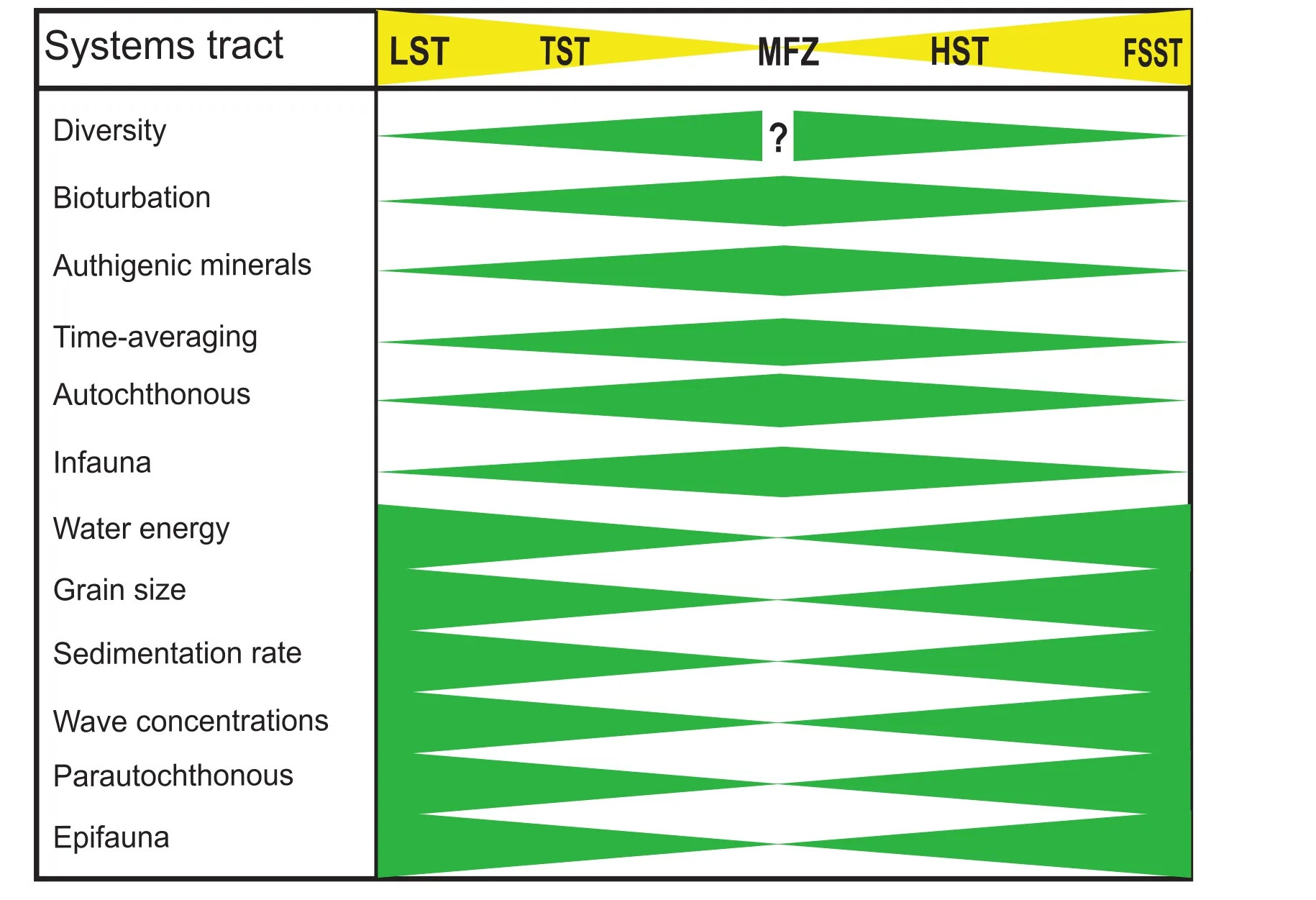
Figure 11 Attributes of the benthic macrofauna within, and sedimentary features of, the third-order sequence stratigraphic framework.The question mark indicates that species diversity at the MFZ may be high or low, depending on environmental conditions.
In general, the macrofauna can be grouped into two main categories. “Immature” communities (paucispecific)occurred when a given environment lost its stability. Such conditions may have developed during the LST or the FSST.In contrast, “mature” communities (polyspecific) developed during the middle to late stage of TST, MFZ, and during the early HST (Abdelhady and Fürsich, 2014). However,in deep settings, unfavourable conditions may also develop during the MFZ or the early HST (Fig. 11) such as dysoxia generated by the establishment of stratified water masses. In addition, shells of these intervals may remain for a prolonged time interval in the diagenetic active zone and hence community relicts may have a high dominance and low diversity.
As the Jurassic macrobenthic associations at Gebel Maghara are autochthonous to parautochthonous, we should differentiate between undistorted and taphonomically distorted associations. As both are genetically different,concentrations of the two modes of preservation exhibit a completely different distribution pattern within the sequence stratigraphic framework. The taphonomically distorted concentrations are usually dense, having been concentrated by waves or current and suffered time-averaging,while the undistorted concentrations are usually dispersed.Physical concentrations occur during the early TST and the late HST (for details see Banerjee and Kidwell, 1991;Fürsich and Pandey, 2003; Wilmsen, 2012), whereas undistorted concentrations occur mainly in the late TST and the MFZ (Fig. 11). However, during the MFZ, time-averaging may distort the primary communities by increasing diversity values, e.g., by faunal mixing.
6.2 Sea-level changes and hydrodynamic conditions
As discussed above, low diversities of some associations were chiefly caused by environmental stress (see also Abdelhady and Fürsich, 2014). There is no direct way in which sea-level fluctuations or hydrodynamic conditions influence species diversity. Holland (2012) suggested that the response of diversity to sea-level changes is likely idiosyncratic. Sea-level change might produce a substantial diversity change at a specific place, whereas an identical sealevel fluctuation might produce little or no diversity change in another place. He also found no link between sea-level changes and diversity in the Phanerozoic fossil record as a whole. However, indirect relationships should be taken into account. Dysoxic and oligotrophic conditions may develop during an early sea-level highstand, in connection with a stratified water mass resulting from low circulation in a deep or restricted inner ramp setting. In addition, soupy substrates, restricting the epifauna, develop only in lowenergy environments, in which fine particles settle from suspension. Sea-level fluctuations influence environmental stability and hence they must have influenced the structure of palaeo-communities (see Abdelhady, 2008; Abdelhady and Elewa, 2010).
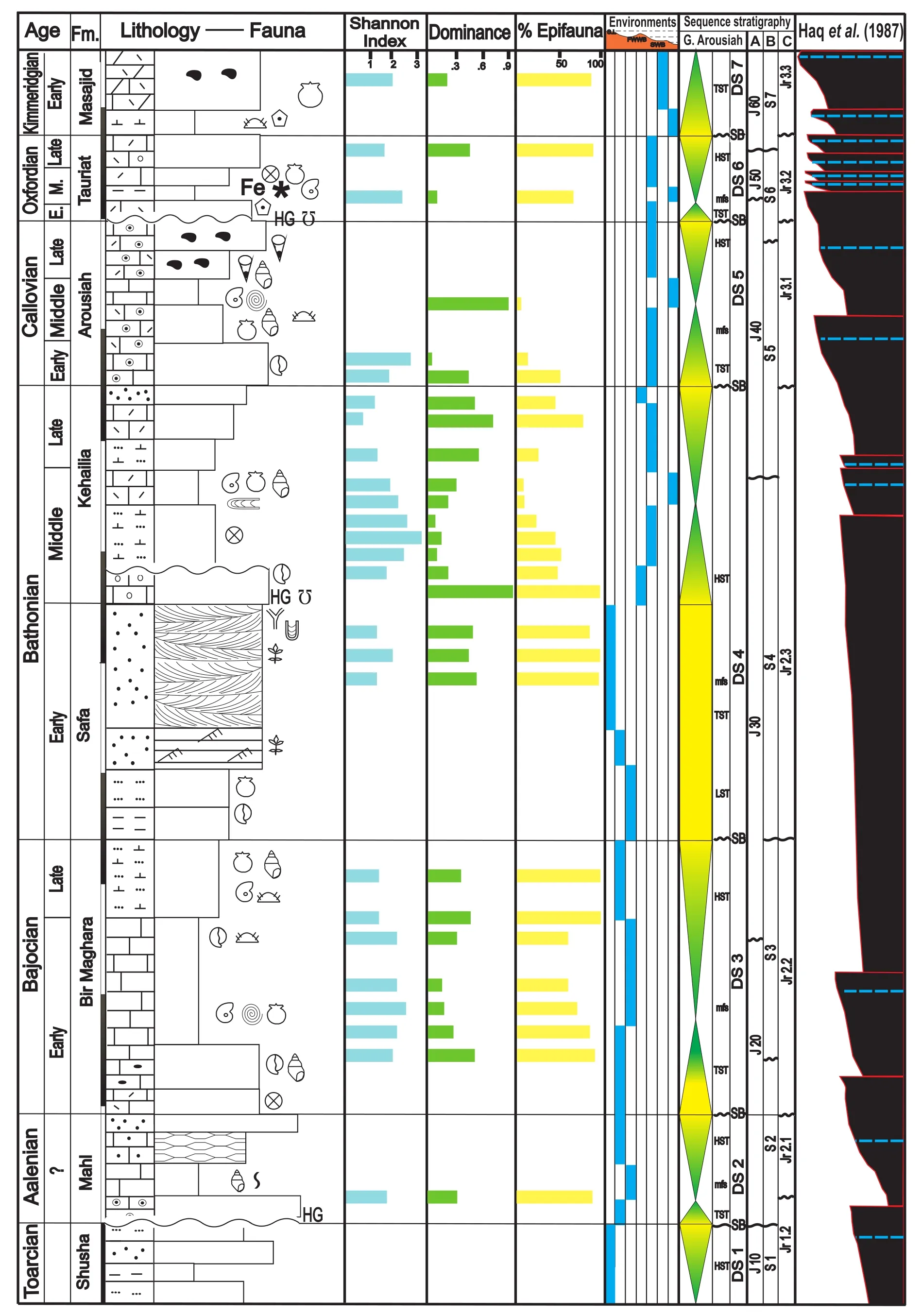
Figure 12 Environmental and sequence stratigraphic interpretations of the Jurassic sedimentary succession exposed at Gebel Maghara.The depositional sequences proposed are compared to adjacent ones in Saudi Arabia (Haq and Al-Qahtani, 2005; A) and in the Levant margin (Gardosh et al., 2008; B and Gardosh et al., 2011; C). Scale = 100 m, for key of symbols see Figure 2.
According to the feeding mode and mode of life, the macrobenthic taxa can be grouped in the following way:(1) Epifaunal suspension-feeders/microcarnivores fed on small plankton and suspended organic matter and there-fore dominated in moderate- to high-energy environments with high productivity during the TST (Fig. 12). (2) Infaunal deposit-feeders fed on organic matter concentrated in the substrate and therefore dominated in low-energy environments with fine-grained siliciclastic sediments usually during the MFZ and the early HST. (3) Epifaunal grazing herbivores/omnivores, which fed on any organic-rich object, are therefore found everywhere and were not restricted to a specific environment (Abdelhady and Fürsich, 2014).
6.3 Eustatic versus tectonic control of sea-level fluctuations
Although the coastal onlap of the Jurassic sediments of Gebel Maghara coincides with the worldwide sea-level curve (Haq et al., 1987, 1988; Fig. 12), the depositional sequences of the Jurassic succession of Gebel Maghara were controlled partly by tectonics. Detailed litho- and biostratigraphic correlations (Fig. 13) show that local fault activity controlled not only the thickness of the deposits but also the depositional environments and thus controlled the sedimentary cycles. It is not an easy task to separate eustatically controlled sea-level fluctuations from tectonically controlled ones.
The depositional sequences of the Mahl and Bir Maghara formations result from eustatic sea-level changes. They are essentially composed of shallow-marine carbonates and, locally and at certain levels, are rich in siliciclastics, which can be correlated throughout all measured sections. In contrast, the occurrence of the 200-m-thick deltaic siliciclastic wedge of the early Bathonian Safa Formation sandwiched between the carbonate ramp facies, more likely results from tectonic reactivation of an old fault. Also, the calcicirudite and calcarenite facies of the early Kimmeridgian depositional sequence (DS 7), which overlies the Oxfordian (DS 6) carbonate mudstone and marl facies and suddenly disappears in the Gebel Mowerib section (Figs 10,13), might be related to tectonics. Abdelhady and Fürsich(2015b) argued also that the change in diversity and extinction rate of the Jurassic macrofauna is related to the basin topography, which has been changed by tectonics.
The stratigraphic boundaries in Gebel Maghara (i.e., the ripple-laminated ferruginous sandstone surface on the top of the Aalenian Shusha Formation, the caliche horizon at the Bajocian-Bathonian boundary, the Thalassinoides-rich bar sandstone (middle Bathonian), the Bathonian-Callovian ferruginous shoal sandstone on the top of the Kehailia Formation, and the hardground at the top of the Callovian Arousiah Formation) all reflect eustatic changes, while the sharp contacts between the Bajocian carbonates and the Bathonian siliciclastic sediments and between the marl and the crinoidal rudstone at the Oxfordian-Kimmeridgian boundary are related to tectonic activity affecting the ramp topography and hence the depositional environments.
In some cases, the pattern of the depositional sequences,which originated primarily from eustatic sea-level fluctuations, might have been enhanced by tectonic movements.A good example is the upper shoreface facies of the Mahl Formation, which originated by the transgression of the sea over the tidal flat area of a recently developed basin. The extensional forces and the resulting subsidence enhanced the facies differentiation by expanding the basin both vertically and laterally and increasing accommodation so that new, deeper facies became established.
6.4 Depositional model
The facies analysis of the succession at Gebel Maghara indicates that sedimentation occurred in a mixed carbonate-siliciclastic system that developed within a halfgraben (Yousef et al., 2010). Facies varied from shallow intertidal to deep outer ramp environments (Table 1; Fig.12). Instead of barrier reefs, the crest of horsts separated the half-graben basin from marine environments during the Early Jurassic and from open marine environments until late Bajocian.
As a result, an extensive restricted lagoon developed, in which storm events were both weak and sporadic. A slope developed during the Kimmeridgian, but this slope differed from a distally steepened ramp of shelf-margin settings.It evolved from a homoclinal ramp and the sediments of the distal slope are autochthonous, as no slump deposits were seen in the field and turbidites are absent. In proximal parts of the slope crinoidal grainstones and rudstones dominated. All these points indicate a high similarity to the Upper Triassic “Steinplatte reef” of the northern Calcareous Alps of Austria (Stanton and Flügel, 1995).
The sections studied indicate that there was a sharp transition from a siliciclastic-dominated inner ramp during the Aalenian-early Bathonian passing into an outer ramp from the middle Bathonian onward. Another sharp transition occurs between the marl-carbonate mudstone-dominated facies (Bathonian-Oxfordian) and the calcareniteand calcirudite-dominated slope facies (Kimmeridgian),resulting from the evolution of the homoclinal ramp into a distally steepened ramp (Fig. 14).
6.5 Basin evolution
During opening of the Neo-Tethys, an extensional tectonic cycle originated. By the Late Triassic/Early Jurassic,the extensional rift setting produced the half graben basin of Gebel Maghara (Fig. 14A). This basin was filled initially with fluvial and deltaic siliciclastic sediments (Fig. 14B).Subsequently, during a phase of tectonic quiescence, a homoclinal ramp developed, on which shallow marine carbonates were deposited (Fig. 14C). During the early Bathonian and in context of a worldwide sea-level lowstand (Haq et al., 1987), the fluvial and deltaic siliciclastic facies of the Safa Formation accumulated over the previously formed marine one (Fig. 14D). The comparatively uniform carbonate successions of the middle Bathonian-Callovian represent a phase of tectonic quiescence (Fig. 14E). However,general tilting and faulting of the basin during the Oxfordian shifted the areas of maximum subsidence northwestward and effectively split the facies of Gebel Maghara into an upper (SE) and lower (NW) slope facies. Rejuvenation of the rift stage during the early Kimmeridgian caused the ramp topography to develop into a distally steepened one(Fig. 14F). Compressional forces at around the Jurassic-Cretaceous boundary resulting from convergence between Africa and Eurasia (Abd El-Motaal and Kusky, 2003) finally closed the basin.
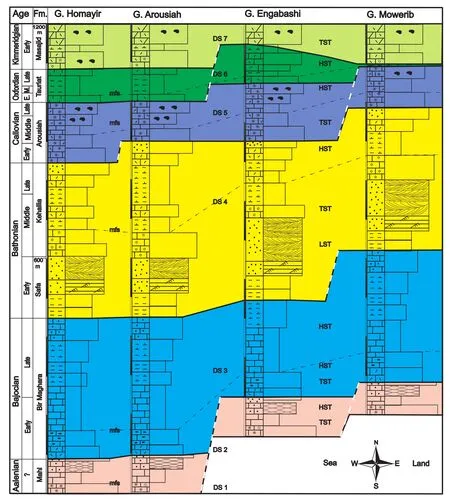
Figure 13 Stratigraphic architecture of the Middle-Upper Jurassic succession of Gebel Maghara. Scale = 100 m, for key of symbols see Figure 2. Lateral changes in thickness are thought to reflect synsedimentary tectonic movements along fault planes. DS 1-DS 7: Depositional sequences; TST: Transgressive systems tract; HST: Highstand systems tract; LST: Lowstand systems tract; mfs: Maximum flooding surface.
7 Conclusions
The Middle and Upper Jurassic mixed carbonate-siliciclastic sedimentary succession of Gebel Maghara has been analysed based on four sections taken along a 20-km-wide continuous outcrop belt. Outcrop observations are combined with detailed microfacies studies. These sections provide the opportunity to illustrate the differences in the geometry and lateral continuity of facies, parasequences,facies successions, and facies heterogeneity, which docu-ment environments varying from tidal flat and delta to open-marine. The Middle and Upper Jurassic succession of Gebel Maghara was deposited on a ramp, and the architecture of this ramp varied from homoclinal to distallysteepened.
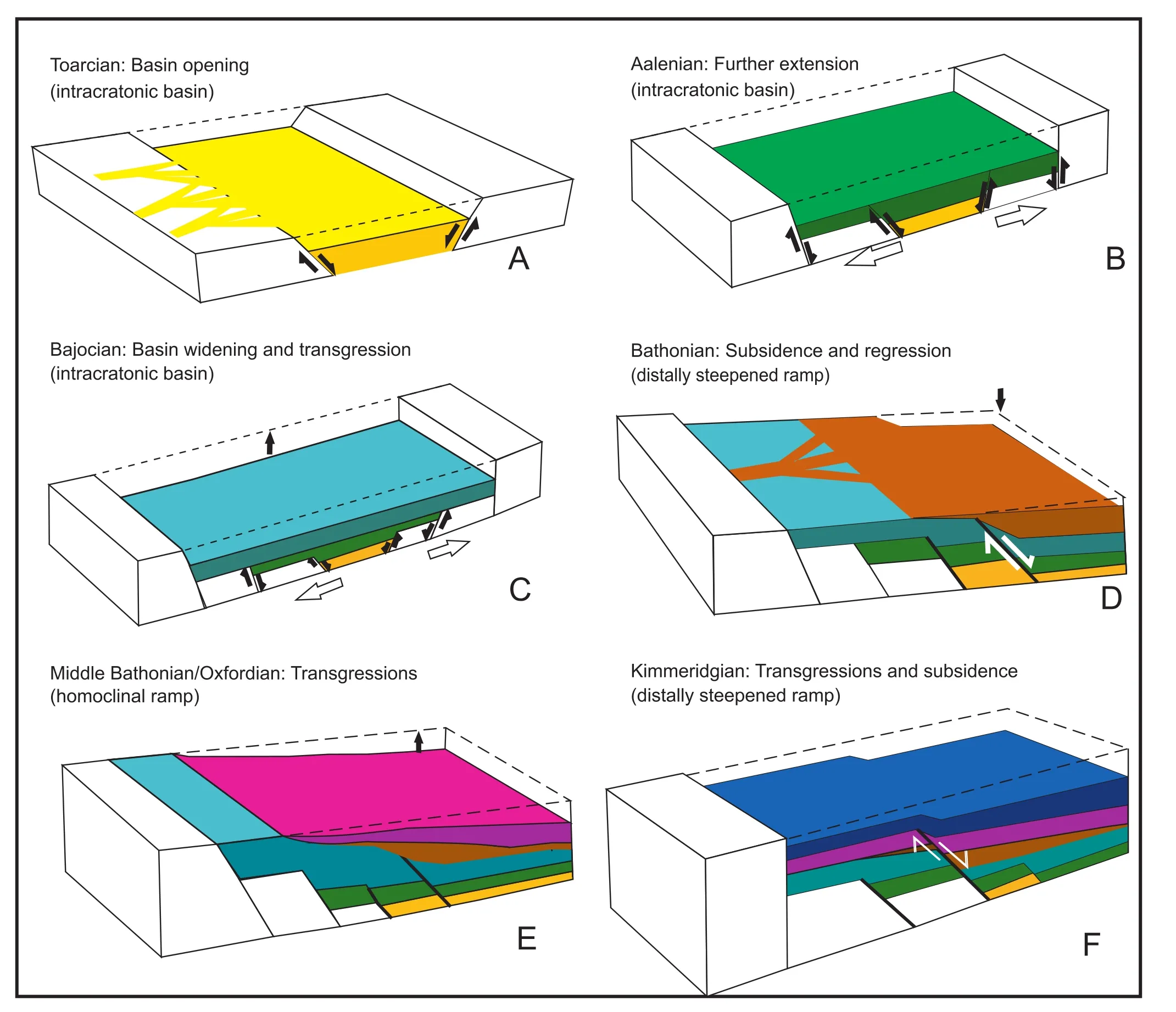
Figure 14 Model of the main stages of the evolution of Gebel Maghara area with schematic time slices depicting the subsidence and depositional history as well as sea-level changes.
The facies study was supported by a palaeoecological study of 232 macrobenthic taxa in 93 stratigraphic samples,the species diversities and epifaunal/infaunal percentages of which were calculated (Abdelhady and Fürsich, 2014).The vertical plots of these parameters show a cyclic pattern, which coincides more or less with the relative changes in sea-level and sequence stratigraphic architecture. The faunal samples were grouped into remnants of low diversity, “immature” communities, which may have developed during unstable intervals (i.e., LST or FSST), whereas high diversity “mature” communities developed during relatively stable intervals, usually the middle to the late stage of TST, MFZ, and during the early HST.
The Jurassic of Gebel Maghara formed within an intracratonic to open extensional rift basin. Sea-level changes and subsidence rates were the decisive factors influencing sedimentation on the ramp. The different lithological elements were controlled by tectonic activity which continuously changed the ramp topography and hence storm intensities. The development of the Jurassic succession of Gebel Maghara can be summarized as follows:
1) An intracratonic half-graben basin developed in the Early Jurassic (probably Toarcian), when a thick package of alluvial to deltaic sandstones was deposited (Shusha Formation, Depositional Sequence 1 (DS 1) ).
2) A carbonate ramp developed at the margin of the basin, and a large lagoon, episodically protected by ooid shoals, developed during the Bajocian. The facies association of this cycle indicates an inner ramp setting with high terrigenous supply (Mahl and Bir Maghara formations, DS 2 and DS 3).
3) A major unconformity occurred at the Bajocian-Bathonian boundary indicating peak regression. For the first time since the late Early Jurassic, the area was subaerially exposed.
4) During the early Bathonian, the global sea-level fall was accompanied in the Gebel Maghara area by faulting and development of a distally steepened ramp resulting in the development of a deltaic system, where a thick sandstone package (Safa Formation, LST of DS 4) accumulated between carbonate ramp sediments.
5) During the middle Bathonian, a second major change occurred when environments deepened, concomitant with a slow sea-level rise and slow subsidence, resulting in the spread of middle to outer homoclinal ramp sediments comprising the Kehailia (TST and HST of DS 4) and Arousiah(DS 5) formations, over the previous inner to middle ramp sediments.
6) During the Callovian, sedimentation switched from marl-dominated to carbonate-dominated.
7) By the Oxfordian, deepening of the sea resulted in deposition of the glauconitic shale of the Tauriat Formation(DS 6).
8) Further subsidence at the beginning of the Kimmeridgian led to development of a distally steepened ramp, on the slope of which a crinoid-grainstone facies became established (Masajid Formation, DS 7).
9) From the Kimmeridgian onwards, the Gebel Maghara Basin started to close by uplifting. Finally, by the late Senonian, the collision of the African-Arabian plate with the Eurasian plate resulted in complete closure of the basin and the development of the Syrian Arc fold system. At that time the area underwent folding and faulting, and Gebel Maghara gained its current structural shape.
Acknowledgements
We acknowledge the staff members of the Desert Research Center (DRC), North Sinai, Egypt, for providing valuable help during the fieldwork and for granting hospitality. Ahmed Awad Abdelhady would like to thank the staffmembers of the Flügel Microfacies Course, GeoZentrum Nordbayern, and in particular Mrs. Birgit Leipner-Mata for preparing the thin-sections. The manuscript is part of the Ph.D. project of Ahmed Awad Abdelhady, who is also grateful to the German Academic Exchange Service (DAAD) and the Egyptian Ministry of Higher Education and Scientific Research (the “GERLS” Programme) for their financial support. The manuscript benefitted from reviews by Zeng-Zhao Feng, Zai-Xing Jiang and Spencer G. Lucas.
 Journal of Palaeogeography2015年3期
Journal of Palaeogeography2015年3期
- Journal of Palaeogeography的其它文章
- Characteristics of the Paleozoic slope break system and its control on stratigraphic-lithologic traps: An example from the Tarim Basin, western China
- Lithofacies architecture and palaeogeography of the Late Paleozoic glaciomarine Talchir Formation, Raniganj Basin, India
- Palaeogeography of a shallow carbonate platform: The case of the Middle to Late Oxfordian in the Swiss Jura Mountains
- 3D palaeogeographic reconstructions of the Phanerozoic versus sea-level and Sr-ratio variations: Discussion
- Reply to comments by G. Shanmugam(2015) and A. J. (Tom) van Loon (2015)on “3D palaeogeographic reconstructions of the Phanerozoic versus sea-level and Sr-ratio variations”
- 2nd International Palaeogeography Conference October 10–13, 2015, Beijing, China
